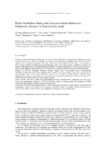Mostrar o rexistro simple do ítem
Motor facilitation during real-time movement imitation in Parkinson’s disease: a virtual reality study
| dc.contributor.author | Robles-García, Verónica | |
| dc.contributor.author | Arias, Pablo | |
| dc.contributor.author | Sanmartín, Gabriel | |
| dc.contributor.author | Espinosa, Nelson | |
| dc.contributor.author | Flores, Julián | |
| dc.contributor.author | Grieve, Kenneth | |
| dc.contributor.author | Cudeiro, Javier | |
| dc.date.accessioned | 2015-04-24T11:39:59Z | |
| dc.date.available | 2015-04-24T11:39:59Z | |
| dc.date.issued | 2013-08-06 | |
| dc.identifier.citation | Robles-García V, Arias P, Sanmartín G, Espinosa N, Flores J, Grieve KL, Cudeiro J. Motor facilitation during real-time movement imitation in Parkinson’s disease: a virtual reality study. Parkinsonism Relat Disord. 2013;19:1123-29. | es_ES |
| dc.identifier.uri | http://hdl.handle.net/2183/14448 | |
| dc.description.abstract | [Abstract] Background: Impaired temporal stability and poor motor unit recruitment are key impairments in Parkinsonian motor control during a whole spectrum of rhythmic movements, from simple finger tapping to gait. Therapies based on imitation can be designed for patients with motor impairments and virtual-reality (VR) offers a new perspective. Motor actions are known to depend upon the dopaminergic system, whose involvement in imitation is unknown. We sought to understand this role and the underlying possibilities for motor rehabilitation, by observing the execution of different motor-patterns during imitation in a VR environment in subjects with and without dopaminergic deficits. Methods: 10 OFF-dose idiopathic Parkinson’s Disease patients (PD), 9 age-matched and 9 young-subjects participated. Subjects performed finger-tapping at their “comfort” and “slow-comfort” rates, while immersed in VR presenting their “avatar” in 1st person perspective. Imitation was evaluated by asking subjects to replicate finger-tapping patterns different to their natural one. The finger-pattern presented matched their comfort and comfort-slow rates, but without a pause on the table (continuously moving). Results: Patients were able to adapt their finger-tapping correctly, showing that in comparison with the control groups, the dopaminergic deficiency of PD did not impair imitation. During imitation the magnitude of EMG increased and the temporal variability of movement decreased. Conclusions: PD-patients have unaltered ability to imitate instructed motor-patterns, suggesting that a fully-functional dopaminergic system is not essential for such imitation. It should be further investigated if imitation training over a period of time induces positive off-line motor adaptations with transfer to non-imitation tasks. | es_ES |
| dc.language.iso | eng | es_ES |
| dc.publisher | Elsevier | es_ES |
| dc.relation.uri | http://dx.doi.org/10.1016/j.parkreldis.2013.08.005 | es_ES |
| dc.rights | This is the author’s version of a work that was accepted for publication in "Parkinsonism & Related Disorders". Changes resulting from the publishing process, such as peer review, editing, corrections, structural formatting, and other quality control mechanisms may not be reflected in this document. Changes may have been made to this work since it was submitted for publication. | es_ES |
| dc.subject | Movement | es_ES |
| dc.subject | Imitative behavior | es_ES |
| dc.subject | Parkinson's disease | es_ES |
| dc.subject | Virtual environment | es_ES |
| dc.title | Motor facilitation during real-time movement imitation in Parkinson’s disease: a virtual reality study | es_ES |
| dc.type | info:eu-repo/semantics/article | es_ES |
| dc.rights.access | info:eu-repo/semantics/openAccess | es_ES |
Ficheiros no ítem
Este ítem aparece na(s) seguinte(s) colección(s)
-
GI-NEURO - Artigos [165]
-
INIBIC-NEURO - Artigos [48]






